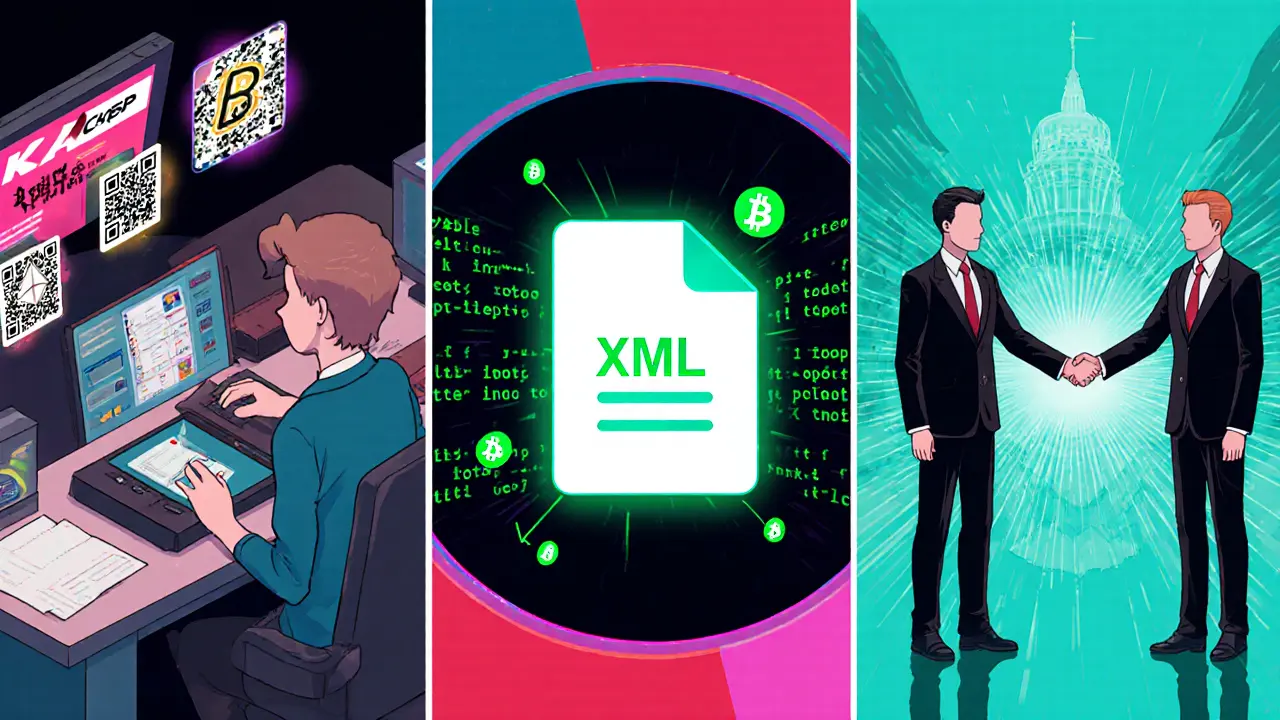How Automatic Crypto Tax Exchange Works Globally

Crypto Tax Reporting Estimator
Reportable Crypto Transactions
This tool estimates whether your crypto transaction would be reportable under CARF and calculates potential tax liability. Note: This is a simplified estimator and not a substitute for professional tax advice.
CARF Reporting Requirements
Under CARF, all transactions that generate taxable income or capital gains must be reported. This includes sales, swaps, staking rewards, interest from lending platforms, and even token airdrops when they have a market value at receipt.
Note: Peer-to-peer trades on decentralized exchanges may require reporting if the DEX qualifies as a Reporting Crypto-Asset Service Provider under local law.
Key Takeaways
- CARF is the OECD’s new rulebook that forces crypto‑asset service providers to share tax data across borders.
- 67 jurisdictions have pledged to adopt the framework by 2028, with the EU leading through DAC8.
- Reporting Crypto‑Asset Service Providers (RCASPs) must collect detailed transaction info and send it via an XML standard.
- Taxpayers will see extra self‑certification forms and may need to disclose holdings on annual returns.
- Technical upgrades, consistent legislation, and cross‑border cooperation are the biggest hurdles.
Imagine you bought Bitcoin on a foreign exchange, sold a slice of Ethereum on a DeFi platform, and never filed a tax return because the data stayed on a blockchain. That scenario used to be a loophole. Today, the crypto tax exchange is becoming a reality thanks to a coordinated push from the Organisation for Economic Co‑operation and Development (OECD). In this guide we’ll break down what the automatic exchange of crypto tax information is, how it actually works, who needs to act, and what it means for the market.
What is the Automatic Exchange of Crypto Tax Information?
At its core, the automatic exchange of information (AEOI) is a global agreement that tax authorities automatically share relevant data about taxpayers who earn income in another country. For traditional finance, AEOI lives under the Common Reporting Standard (CRS). When it comes to crypto‑assets, the OECD introduced a dedicated set of rules called the Crypto-Asset Reporting Framework (CARF) a reporting regime that obliges crypto‑asset service providers to collect and exchange tax‑relevant data with the taxpayer’s country of residence. CARF extends CRS so that digital assets-tokens, stablecoins, NFTs, and even central‑bank digital currencies-don’t slip through the cracks.
How CARF Works: The Reporting Flow
The framework creates a three‑step loop:
- Data collection: Reporting Crypto‑Asset Service Providers (RCASPs) must gather details on every customer transaction that could generate taxable income. This includes the type of asset, date, amount, wallet addresses, and the taxpayer’s self‑certified residency information.
- Standardised transmission: All collected fields are packed into an XML file that follows the OECD XML User Guide released in October 2024. The file is sent annually to the jurisdiction where the user lives.
- Cross‑border exchange: Each participating tax authority receives the XML, imports it into their existing CRS system, and matches it against local tax returns. If a mismatch appears, the authority can issue a notice or audit.
Because the data move automatically, there’s no need for a separate request or a bilateral treaty. The process mirrors how banks already report interest or dividends under CRS, just with extra crypto‑specific fields.

Global Adoption Timeline
The rollout is happening fast. In November 2023 the OECD announced that 67 jurisdictions-up from an initial 54-had committed to adopt CARF by 2028. Here are the marquee players:
- European Union adopted the rules through DAC8, the eighth amendment to the Directive on Administrative Cooperation. Member states must transpose DAC8 by 31 December 2025, start applying it on 1 January 2026, and file their first reports in 2027.
- United States Internal Revenue Service (IRS) will require non‑U.S. brokers to report U.S. customer data under the CARF model, while also sharing information about foreign persons who trade on U.S. platforms.
- Major crypto‑friendly jurisdictions such as Singapore, Switzerland, and the United Arab Emirates have sign‑posted intentions to implement the framework, but many are still drafting the exact legislation.
By the end of 2025 most large economies should have the legal foundations in place, with operational reporting beginning in 2026‑2027.
What Taxpayers and Service Providers Need to Do
If you hold crypto assets, expect a few new obligations on your next tax return:
- Complete an annual self‑certification form that includes your residency, taxpayer identification number, and a declaration of crypto holdings.
- Report income from sales, swaps, staking rewards, and any crypto‑derived interest. The definition of “income” follows each jurisdiction’s tax code but generally mirrors capital‑gain treatment.
For crypto‑asset platforms, the checklist looks heavier:
- Upgrade KYC workflows to capture the residency data required by CARF.
- Build or buy a compliance engine that extracts transaction details (date, amount, wallet address) in real time.
- Validate the data against the XML schema and generate the annual report file.
- Establish a secure transmission channel to the local tax authority or to the central OECD gateway, depending on the country’s set‑up.
Many providers are already partnering with RegTech firms that specialize in CRS‑compatible reporting. The market for such solutions is booming, and the sooner a platform integrates the stack, the smoother the transition for its users.
Technical Challenges and Practical Solutions
Moving from a voluntary self‑reporting culture to a mandatory, automated exchange brings three big technical pain points:
- Data completeness: Crypto trades can happen on‑chain without an intermediary. Platforms must decide how to capture peer‑to‑peer swaps that occur off‑exchange.
- Standardisation across blockchains: Different protocols store transaction metadata differently. A unified mapping layer is needed to translate Ethereum logs, Solana accounts, and Bitcoin UTXOs into the same XML fields.
- Processing volume: Some large exchanges handle millions of transactions per day. Their back‑end systems need to generate, validate, and store massive XML files while ensuring data integrity.
Solutions that are gaining traction include:
- Using blockchain‑analytics providers (e.g., Chainalysis, CipherTrace) to enrich raw on‑chain data with address‑owner attribution.
- Deploying a middle‑layer API that normalises transaction data into a CARF‑compatible JSON payload before converting to XML.
- Adopting cloud‑native data pipelines (AWS Glue, Azure Data Factory) that scale automatically during the annual reporting window.
Tax administrations also need to upgrade their intake systems. The OECD’s XML User Guide includes sample schema definitions that many jurisdictions are copying verbatim, which should help reduce the time needed for national IT teams to build parsers.

Impact on the Crypto Market
The biggest question on everyone’s mind: will stricter reporting kill crypto activity? The evidence so far suggests a nuanced outcome:
- Liquidity shift: Jurisdictions with higher compliance costs may see a modest outflow of volume to friendlier markets. However, the global nature of crypto means that large pools of liquidity remain accessible across borders.
- Pricing effects: In regions where reporting thresholds are low, traders may price in a small “compliance premium.” This is similar to the modest spread increase seen after the EU introduced DAC6 for intermediary reporting.
- Investor confidence: Institutional players often view greater transparency as a positive signal. Clear tax‑compliant pathways could attract more pension‑fund‑type money into crypto funds.
Overall, the framework aims to level the playing field-keeping crypto‑friendly jurisdictions competitive while ensuring that tax evasion opportunities shrink.
Future Outlook: Beyond 2028
CARF is designed as a living framework. The OECD has already hinted at future expansions to cover:
- Decentralised finance (DeFi) protocols that act as “automated market makers” without a traditional intermediary.
- Non‑fungible tokens (NFTs) that generate royalties or licensing income.
- Central bank digital currencies (CBDCs) as they become widely used for cross‑border payments.
As the ecosystem matures, we can expect periodic updates to the XML schema, similar to how the CRS has been amended every few years to capture new financial products. Keeping an eye on the OECD’s “Implementation Tracker” will be crucial for tax advisors and platform operators alike.
Quick Checklist for 2025‑2026
- Review your jurisdiction’s CARF transposition timeline (EU members = Dec 31 2025, others ≈ mid‑2025).
- If you run a crypto‑exchange or wallet service, start a compliance project now-budget for data collection, XML generation, and staff training.
- Taxpayers: gather all wallet addresses, exchange statements, and staking reward records. Expect a new line item on your 2026 tax return.
- Watch for the release of the “2026 Technical Addendum” which will add fields for DeFi yield‑farm rewards.
- Consider partnering with a RegTech vendor early; the best‑in‑class solutions are already booked out for 2024‑2025 implementation slots.
What types of crypto transactions must be reported under CARF?
All transactions that generate taxable income or capital gains must be reported. This includes sales, swaps, conversions, staking rewards, interest from lending platforms, and even token airdrops when they have a market value at receipt.
Do peer‑to‑peer trades on decentralized exchanges need to be reported?
If a decentralized exchange (DEX) qualifies as a Reporting Crypto‑Asset Service Provider under local law, it must collect the same data as a centralized platform. Many jurisdictions are still drafting guidance, so platforms should err on the side of compliance.
When will the first automatic exchange reports be filed?
The EU’s first reporting year is 2026, with data exchanged in 2027. The United States and most non‑EU jurisdictions aim for a similar 2026‑2027 window, depending on when they transpose the legislation.
How will the XML file be transmitted to tax authorities?
Most jurisdictions will use a secure web‑service endpoint defined by the OECD. Some will route the XML through a national tax portal that then forwards it to the OECD’s central hub.
What penalties exist for non‑compliance?
Penalties vary by country but typically include fines up to 5% of the reported transaction volume, possible suspension of operating licences for platforms, and criminal charges for deliberate tax evasion.
Marina Campenni
February 24, 2025 AT 10:59Thanks for laying out the groundwork so clearly; the way the CARF framework ties into existing CRS rules makes the whole process feel less opaque. I appreciate the emphasis on the practical steps platforms need to take, especially the data‑collection and XML generation phases. It’s reassuring to see that the OECD is providing a concrete technical standard rather than leaving it to guesswork.
Irish Mae Lariosa
March 1, 2025 AT 01:23While the overview is undeniably thorough, it overlooks the sheer operational burden that midsized exchanges will face when retrofitting legacy systems to meet the XML schema requirements, a burden that could prove prohibitive without substantial capital infusion; furthermore, the timeline presented assumes an almost uniform legislative rollout across jurisdictions, an assumption that ignores the notorious lag in transposition observed in several EU member states, where political gridlock often pushes compliance dates well beyond the stipulated deadlines, thereby creating a fragmented reporting environment that defeats the very purpose of a harmonised global standard, and finally, the guide’s optimism about “technical upgrades” fails to account for the scarcity of qualified RegTech talent, a shortage that may inflate implementation costs far beyond the modest estimates suggested herein.
Nick O'Connor
March 5, 2025 AT 15:47Indeed, the three‑step loop-data collection, standardized transmission, and cross‑border exchange-mirrors the existing CRS workflow, yet the addition of wallet addresses and on‑chain identifiers introduces a layer of complexity that tax authorities must be prepared to parse; consequently, agencies should invest in analytics tools capable of reconciling blockchain data with traditional tax records, and regulators ought to issue detailed guidance on handling pseudo‑anonymous transactions, thereby reducing ambiguity for both reporting entities and taxpayers.
Matthew Theuma
March 10, 2025 AT 06:11It’s fascinating how the crypto world is finally being pulled into the same gravity well as traditional finance; maybe this is the universe’s way of saying that nothing stays underground forever 🌌. From a philosophical standpoint, the push for transparency could be seen as a collective acknowledgement that trust is built on visibility, not secrecy. Sure, the tech hurdles are real, but every paradigm shift has had its growing pains, right? Let’s hope the ecosystem adapts without losing the creative spark that made it popular in the first place 😅.
Carolyn Pritchett
March 14, 2025 AT 20:35This “glorious” transition is nothing but a smokescreen for governments to clamp down on innovation, and the so‑called “technical upgrades” are just a costly excuse to force every startup into the hands of big‑tech RegTech vendors. Don’t be fooled by the romanticized narrative; the reality is a looming compliance tax that will choke liquidity and drive the most agile players into the shadows where they’ll be even harder to regulate.
Jason Zila
March 19, 2025 AT 10:59The emphasis on partnering with RegTech firms suggests that the market is already maturing, and it hints at a future where compliance becomes a service rather than a burden; this could lower entry barriers for smaller projects that can simply plug into an existing compliance API instead of building their own stack.
Cecilia Cecilia
March 24, 2025 AT 01:23Such plug‑in solutions could indeed streamline adoption while preserving regulatory integrity.
lida norman
March 28, 2025 AT 15:47Wow, the idea of a global crypto tax net feels like a huge wave crashing over the whole market 🌊! It’s scary but also kind of thrilling to think about all that data finally being gathered in one place 😱.
Schuyler Whetstone
April 2, 2025 AT 06:11All this hype is just a cover‑up for the state to steal your coins, and anyone who buys into it is basically signing their own financial death warrant.
Pierce O'Donnell
April 6, 2025 AT 20:35Honestly, I think the whole CARF thing will just push traders to off‑shore services that ignore any reporting.
Vinoth Raja
April 11, 2025 AT 10:59When we dissect the CARF architecture, we see a classic case of regulatory recursion where the metadata layer attempts to encapsulate the entirety of on‑chain activity within a deterministic schema, a pursuit that borders on the metaphysical ambition of encoding decentralised truth into a centrally consumable format. The XML payload, while syntactically strict, is essentially a flattened representation of a graph‑structured ledger, and that flattening incurs a loss of context that auditors will inevitably struggle to reconcile with real‑world economic substance. Moreover, the reliance on third‑party blockchain analytics introduces an epistemic dependency, as the veracity of address attribution becomes a function of proprietary heuristics rather than an immutable consensus. From a systems‑theoretic perspective, the feedback loop created by mandatory reporting can be modelled as a control signal that dampens volatility in tax evasion, yet it also adds latency to the information propagation pipeline, which could impair real‑time compliance monitoring. The devil is in the data‑quality pipeline: ingestion, normalization, enrichment, and finally transformation into the OECD‑defined schema each present a choke point that could cascade into systemic bottlenecks if not architected with elastic cloud‑native patterns. In practice, we’re likely to observe a bifurcation where large exchanges invest in bespoke compliance engines, while smaller DeFi protocols either outsource to RegTech SaaS platforms or double down on anonymity to retain user trust. This divergence mirrors the classic winner‑takes‑all dynamics observed in other regulated industries during a period of rapid policy shift. On the geopolitical front, jurisdictions that lag in transposition risk becoming havens for arbitrage, a phenomenon that could inadvertently reinforce the very tax‑base erosion the framework seeks to mitigate. The OECD’s choice of a centralized XML gateway versus a federated API model also raises questions about data sovereignty, especially for nations with strict data‑localisation statutes. Finally, the long‑term sustainability of CARF will depend on iterative schema updates that can gracefully accommodate emerging asset classes such as synthetic derivatives and tokenized real‑world assets, lest the framework become obsolete within a few years. In summary, while the intent behind CARF is commendable, its execution will hinge on a delicate balance between technical rigor, regulatory cooperation, and the adaptable resilience of the crypto ecosystem.